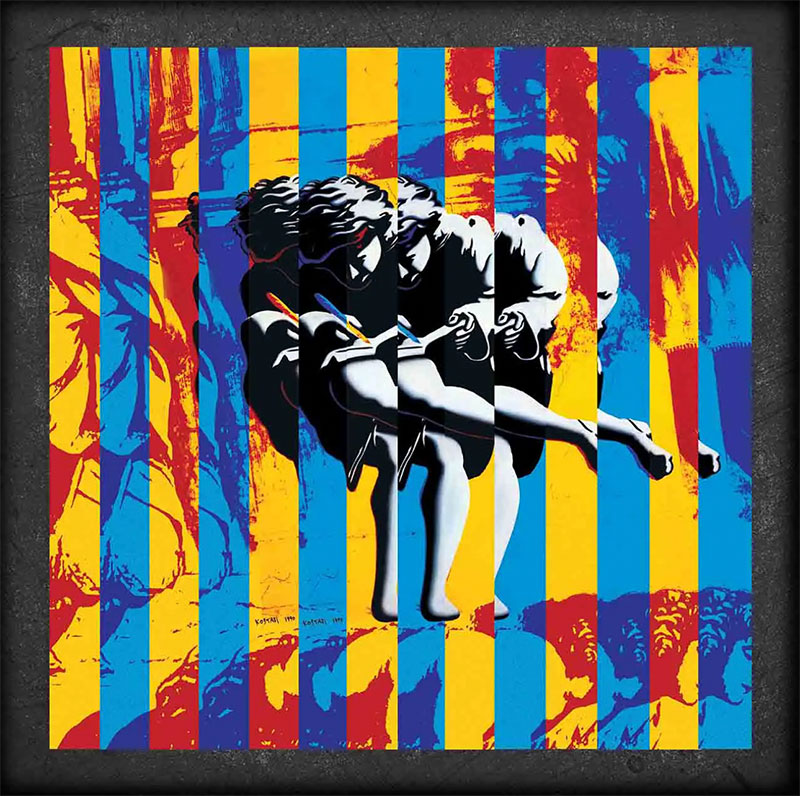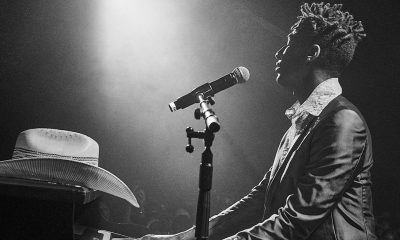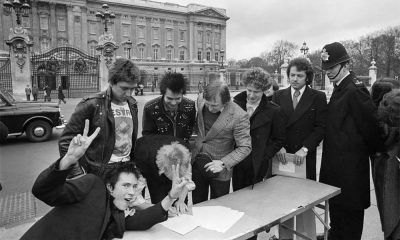News
Use Your Illusion: Gun N’ Roses Double Down On Their Ambitious Artistic Aspirations


What’s your next move when you’re already the world’s biggest rock band? That was the question hanging over Guns N’ Roses after their all-conquering debut album, Appetite For Destruction, sold millions of copies. The group’s answer: Double down on their artistic aspirations and simultaneously release two ambitious and frequently astonishing albums, Use Your Illusion I & II.
“We want to define ourselves,” frontman Axl Rose told Rolling Stone in 1990. “Appetite For Destruction was our cornerstone, a place to start. That was like, ‘here’s our land, and we just put a stake in the ground – now we’re going to build something.’”
Order Guns N’ Roses Use Your Illusion I & 2 ultimate editions.
Rose was as good as his word. Yet, while both volumes of Use Your Illusion are now widely regarded as Guns N’ Roses’ most seminal artistic statements, creating them almost finished the band off on more than one occasion.
The early sessions
Indeed, when they tried to compile new material at an initial pre-production session in Chicago in June 1989, Guns N’ Roses were in disarray. Rhythm guitarist Izzy Stradlin often failed to show, and Axl Rose drifted in and out of the session. Often bored and distracted, the rest of the band couldn’t agree on the direction their new music should take.
Looking back on this frustrating period, lead guitarist Slash told Classic Rock, “It was definitely exploratory compared to Appetite For Destruction. I mean, honestly, I’d have preferred to do a record with just 10 f_ing songs that were a bit more straightforward, but it was an opportunity to finally get the band to work again.”
With hindsight, the Chicago session wasn’t a complete disaster. The band worked up the basics for key Use Your Illusion tracks such as “Garden Of Eden” and the swaggering, Aerosmith-esque rocker “Bad Apples” during this period. Another key song that emerged, “Estranged,” was the result of the time Axl Rose spent pounding the studio piano in Chicago. Writing this atypically emotive ballad proved a decisive early breakthrough, for it suggested that Use Your Illusion would be far broader in scope than Appetite For Destruction.
An inspiring return to Los Angeles
Yet, after they returned to Los Angeles, Guns N’ Roses still had numerous issues to overcome before their new recordings could get off the ground. Most notably, narcotic use was still abundant within the band, though they turned a corner when Slash managed to clean up his act. “How was I doing personally back then?” he mused in an interview with Classic Rock. “Well, by then, I was off smack, so that was good. That was like the motivator for me. So I was having a good time just doing my regular heavy drinking as normal.”
A string of jam sessions at L.A’s Mates rehearsal space further confirmed that Guns N’ Roses still had musical chemistry without the same level of chemical input. Gaining in confidence, the band played a series of well-received shows supporting The Rolling Stones in the US and hung onto their new-found creativity when they embarked on a feverish, two-night writing session at Slash’s house in Los Angeles’ Laurel Canyon Hills.
During this intensive spell, Slash, Rose, Stradlin, and bassist Duff McKagan finished off a raft of Use Your Illusion’s best songs, not least “The Garden,” McKagan’s Johnny Thunders tribute, “So Fine,” and Rose’s furious, anti-media diatribe, “Get In The Ring.” They also worked up a number of Stradlin-penned tracks, including “Double Talkin’ Jive” – a crunching rocker inspired by an especially grisly real-life event during a previous recording session when the police found dismembered body parts in a dumpster behind the studio.
“All I know is that we didn’t do it,” Slash later wrote in his memoir, Slash: The Autobiography. “But Izzy turned the event into a lyric on ‘Double Talkin’ Jive.’ And I got to play that little Spanish flamenco part on it.”
A new drummer
By this stage, things were looking up in the Guns N’ Roses camp. Yet when the band made their first fully-fledged foray into the studio to cut the epic protest song, “Civil War,” they discovered they had another issue to address before they could concentrate fully on nailing Use Your Illusion. “[That was] the first song when we went into the studio with [drummer] Steven [Adler],” said Slash later. “And [we] realized that he wasn’t really playing up to par.”
To replace him, the band drafted in Matt Sorum, formerly of popular UK rock act The Cult. Slash recalled: “I remembered seeing Matt with The Cult and thinking that he was the only good drummer I’d seen, and calling him and having him come down. We started rehearsing this material, and next thing you know, we’re in the studio.”
The recording sessions
With their new drummer on board, Guns N’ Roses were finally ready to lay the foundations for their twin albums with assistance from Appetite For Destruction producer Mike Clink. Despite their vast wealth of new material, the sessions went relatively quickly. “We did what we always did,” Slash told Classic Rock. “We went in the studio with the band in one room and just played the songs live, and that’s what goes on the record. But because I don’t like headphones, I’d go in there and play along with the band for the vibe and the energy. Then I’d go back into the studio afterward, get in the control room and do my guitar parts there. Before you knew it, we’d done the basic tracks for all the songs in 36 days.”
While the initial sessions went smoothly, painstaking overdubbing took longer, and tensions again bubbled to the surface during the album’s mixing stage, resulting in engineer Bob Clearmountain being replaced by Bill Price, famous for his work on punk era classics such as Never Mind The Bollocks…Here’s The Sex Pistols and The Clash’s London Calling. In retrospect, Slash wasn’t surprised that getting the two Use Your Illusion albums over the line proved difficult: “When you have 30 different songs, different approaches, written at different times, you want to paint each song a certain color,” the guitarist told Classic Rock. “It called for a more intellectual approach than we were used to.”
The diversity of the two albums
Bearing out Slash’s comments, the breadth of diversity apparent across both volumes of Use Your Illusion demonstrated that Guns N’ Roses now had way more to offer than sleazy, testosterone-fueled anthems. Use Your Illusion I, for example, contained the 10-minute “Coma,” which was written by Slash when he was sharing a home in the Hollywood Hills with Izzy Stradlin. This intense, riff-heavy behemoth of a track was based around what the lead guitarist described as “a repeating pattern that got increasingly mathematical” in his memoir. It’s lost none of its hypnotic presence today.
Elsewhere, Use Your Illusion I found Guns N’ Roses surprising rock fans of all stripes with their surprisingly effective cover of Paul McCartney and Wings’ James Bond theme, “Live And Let Die.” Slash and Axl Rose decided to work this one up after discovering their mutual love of the track. Rose later told Rolling Stone, “We didn’t think we were good enough to get it done right,” but GNR’s dramatic take on the song has an inherent power all its own, much of which Slash later attributed to Rose’s work on the song’s synthesizer arrangements. “What Axl did was really complex,” the guitarist noted. “He spent hours… getting the nuances just right.”
Rose truly came into his own, however, on Use Your Illusion’s widescreen ballads “November Rain,” “Estranged,” and “Don’t Cry.” The latter (which was also afforded a more somber makeover for Use Your Illusion II) provided GNR with a Top 10 hit on both sides of the Atlantic, but it’s less celebrated than the lauded “November Rain,” which Rose had been working on since the mid-1980s.
Finally completed for Use Your Illusion I, “November Rain” clocked in at an extravagant nine minutes and boasted ornate piano melodies, synthesizer-programmed strings, and no less than three searing Slash solos. Later peaking at No. 3 on the Billboard Hot 100 as a single, the song was promoted by a suitably lavish video costing $1.5 million. It arguably remains GNR’s most epic track and, in 2018, became the first music video from the 1990s to reach the 1 billion view achievement and is now about to cross over 2 billion views.
Use Your Illusion II also captured numerous examples of Guns N’ Roses at their most innovative. The hard-hitting protest song “Civil War” included a smorgasbord of samples (ranging from snatches of dialogue from the film Cool Hand Luke through to an excerpt from a speech delivered by a Peruvian Shining Path guerrilla officer), while on “Locomotive (Complicity),” Guns N’ Roses dabbled with a funk-metal groove akin to Red Hot Chili Peppers or Faith No More. The record’s closing track, “My World,” even pointed the way toward the industrial and electronic stylings Guns N’ Roses would explore further on 2008’s Chinese Democracy.
The release
The simultaneous release of both volumes of Use Your Illusion on September 17, 1991, was one of rock’s biggest calendar events of that year. With only 1988’s hastily-assembled G N’ R Lies to tide them over following Appetite For Destruction, the band’s fan base was ravenous, and they quickly devoured the new releases.
Unsurprisingly, the two albums debuted atop the Billboard 200, with the slightly more accessible Use Your Illusion II initially making it to No. 1, selling 770,000 copies in its first week alone. These sprawling and frequently brilliant records have since established themselves as firm favorites with successive generations of rock fans who continue to marvel at what the Chicago Tribune’s review referred to as representing a “staggering leap in ambition, musicianship, production, and songwriting.”
“You know, when I look back on it, it was a monumental achievement,” Slash told Louder Sound in 2021. “The first thing I think of when I think of those albums is that it was such a whirlwind of s–t was happening at that particular time, but it was a huge accomplishment to get those records made. I think the Use Your Illusion records were victorious, if you know the back story. It was an epic journey, and after all of it, we came through.”
Order Guns N’ Roses Use Your Illusion I & 2 ultimate editions.

-
Paul McCartney And Wings To Release Historic Live Album ‘One Hand Clapping’
-
Elton John Earns Multi-Platinum Plaque For ‘Diamonds,’ Shares ‘Step Into Christmas’ EP
-
Jon Batiste Announces ‘Uneasy Tour: Purifying The Airwaves For The People’
-
Best Political Punk Songs: 20 Essential Anti-Establishment Tirades





